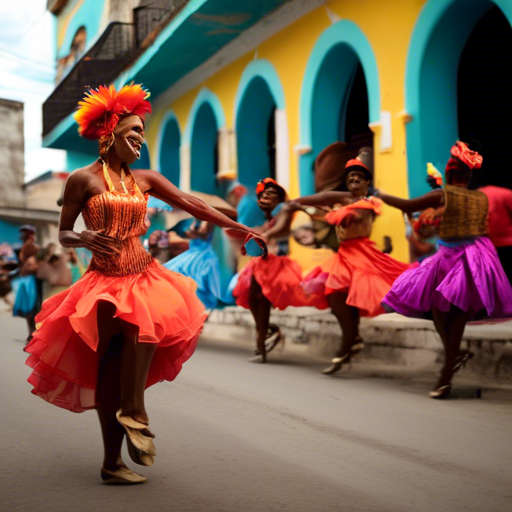the vibrant world of cuban music and dance traditions

The Vibrant World of Cuban Music and Dance Traditions
Cuban music and dance traditions are a rich tapestry woven from diverse cultural influences, historical contexts, and vibrant communities. As we delve into this fascinating subject, we will explore the origins, evolution, and contemporary significance of these art forms. This article aims to provide a comprehensive overview of Cuban music and dance, highlighting key genres, notable figures, and the cultural impact of these traditions.
Historical Roots of Cuban Music and Dance
The history of Cuban music and dance is deeply intertwined with the island's colonial past and its African, Spanish, and indigenous influences. The fusion of these diverse elements has given rise to unique and dynamic art forms that continue to captivate audiences worldwide.
African Influence
African rhythms and instruments have played a crucial role in shaping Cuban music. The arrival of African slaves brought with it a rich musical heritage that has left an indelible mark on Cuban culture. Key African contributions include:
- Drumming: The use of drums such as the conga and bata is central to many Cuban music genres.
- Call-and-response: This vocal technique is prevalent in genres like rumba and son.
- Polyrhythms: Complex rhythmic patterns that are a hallmark of Cuban music.
Spanish Influence
Spanish colonization introduced European musical elements to Cuba, including melodies, harmonies, and instruments such as the guitar and piano. These influences are evident in genres like danzón and bolero.
Indigenous Influence
Although less pronounced, the indigenous Taino people contributed to Cuban music through their use of percussion instruments and ceremonial dances.
Key Genres of Cuban Music
Cuban music encompasses a wide range of genres, each with its own distinct characteristics and cultural significance. Some of the most notable genres include:
Son Cubano
Son Cubano is often considered the foundation of modern Cuban music. Originating in the eastern region of Cuba, this genre combines African rhythms with Spanish guitar melodies. Key elements of son include:
- Clave rhythm: A syncopated pattern that serves as the backbone of the music.
- Montuno: A repetitive piano or guitar riff that drives the rhythm.
- Improvisation: Both vocal and instrumental improvisation are central to son.
Salsa
Salsa is a popular genre that evolved from son and other Cuban styles. It gained international fame in the mid-20th century and is characterized by its energetic rhythms and vibrant dance moves. Key features of salsa include:
- Brass instruments: Trumpets and trombones add a lively, brassy sound.
- Fast tempo: Salsa music is typically upbeat and danceable.
- Partner dancing: Salsa is known for its intricate and sensual partner dance routines.
Rumba
Rumba is a genre deeply rooted in African traditions and is known for its complex rhythms and expressive dance styles. There are three main types of rumba:
- Yambú: A slow and graceful dance.
- Guaguancó: A faster, more flirtatious dance.
- Columbia: A solo male dance characterized by acrobatic movements.
Notable Figures in Cuban Music and Dance
Throughout history, numerous artists have made significant contributions to Cuban music and dance. Some of the most influential figures include:
Benny Moré
Benny Moré, known as "El Bárbaro del Ritmo," was a legendary singer and bandleader whose powerful voice and charismatic stage presence left a lasting impact on Cuban music. His repertoire included genres such as son, bolero, and mambo.
Celia Cruz
Celia Cruz, the "Queen of Salsa," was a Cuban singer who achieved international fame with her dynamic performances and distinctive voice. Her contributions to salsa music have made her an enduring icon in the genre.
Compay Segundo
Compay Segundo was a renowned musician and composer best known for his work with the Buena Vista Social Club. His mastery of the tres guitar and his contributions to son cubano have cemented his place in Cuban music history.
The Cultural Impact of Cuban Music and Dance
Cuban music and dance have had a profound impact on both the island's culture and the global music scene. These art forms serve as a means of cultural expression, social cohesion, and national identity.
Tourism and Cultural Exchange
Cuban music and dance attract tourists from around the world, contributing to the island's economy and fostering cultural exchange. Visitors often participate in dance classes, attend live performances, and explore the rich musical heritage of Cuba. For more information on travel opportunities, visit this travel site.
Global Influence
The influence of Cuban music extends far beyond the island's shores. Genres like salsa, mambo, and cha-cha-cha have become staples of Latin music worldwide. Cuban musicians have collaborated with international artists, further spreading the island's musical legacy.
Social and Political Significance
Music and dance have played a crucial role in Cuban social and political movements. They have been used as tools for resistance, solidarity, and cultural preservation. During the Cuban Revolution, for example, music was a powerful medium for conveying revolutionary ideals and uniting the populace.
FAQ
| Question | Answer |
|---|---|
| What are the main genres of Cuban music? | Some of the main genres include son cubano, salsa, and rumba. |
| Who are some notable figures in Cuban music? | Notable figures include Benny Moré, Celia Cruz, and Compay Segundo. |
| How has Cuban music influenced global music? | Cuban music has influenced global music through genres like salsa, mambo, and cha-cha-cha, and through collaborations with international artists. |
| What role does dance play in Cuban culture? | Dance is a vital aspect of Cuban culture, serving as a means of cultural expression, social cohesion, and national identity. |
For those interested in exploring the vibrant world of Cuban music and dance, there are numerous resources and travel opportunities available. To learn more, visit this travel site.
```